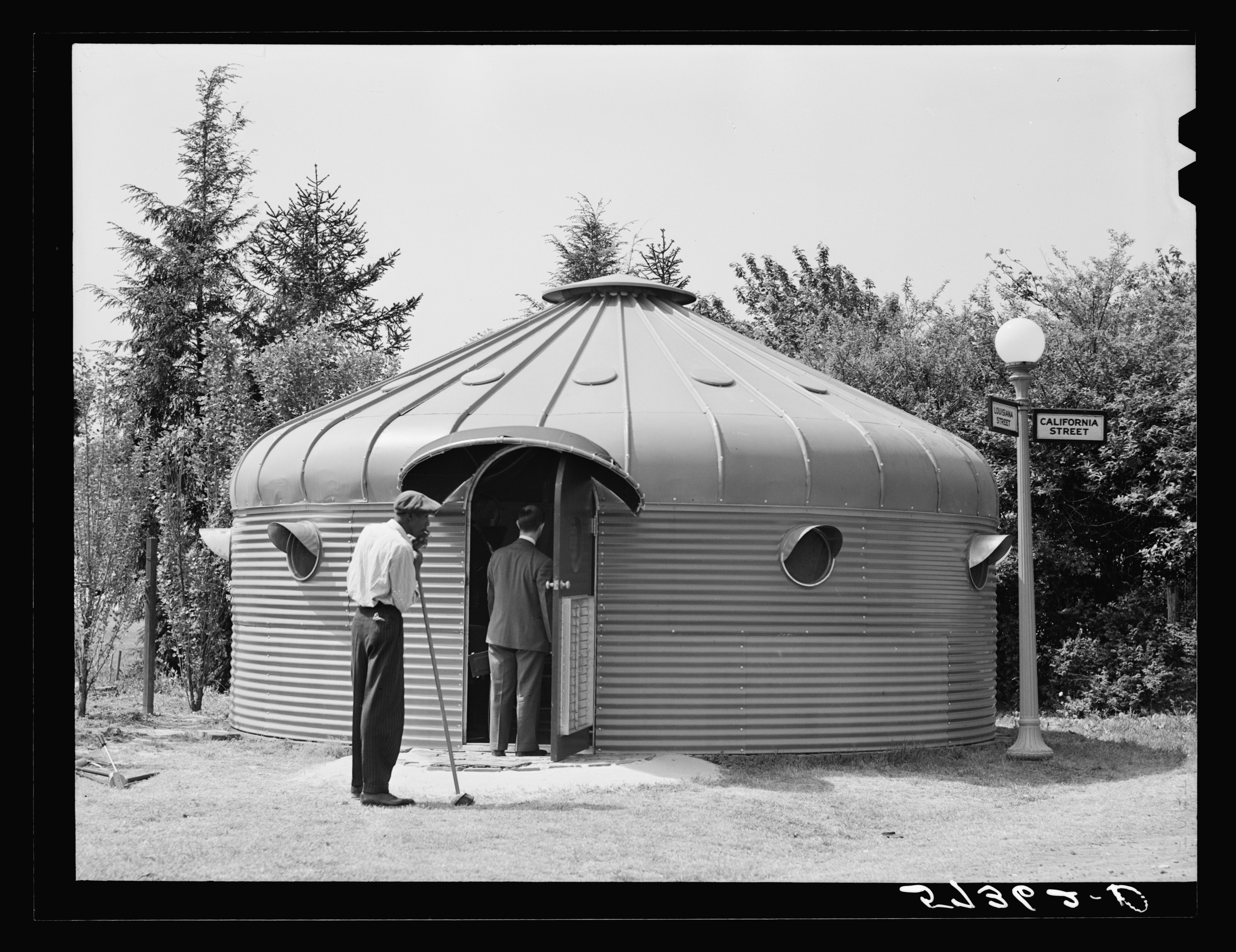|
Dymaxion
Dymaxion is a term coined by architect and inventor Buckminster Fuller and associated with much of his work—prominently his Dymaxion house and Dymaxion car. Dymaxion, a portmanteau of the words ''dynamic'', ''maximum'', and ''tension''; sums up the goal of his study, "maximum gain of advantage from minimal energy input." Description A name was needed for the display of Fuller's first architectural model, later to be known as the Dymaxion house, at the Marshall Field's department store in Chicago. To create the name, wordsmith Waldo Warren was hired by Marshall Field's and spent two days listening to Fuller, getting a feel for his idiosyncratic use of language—later playing with the syllables typical of Fuller's speech until he and Fuller agreed on the word ''Dymaxion''. Fuller used the word for many of his inventions during the decades to follow, including the Dymaxion house, the Dymaxion deployment unit, the Dymaxion car, and the Dymaxion world map. Dymaxion ... [...More Info...] [...Related Items...] OR: [Wikipedia] [Google] [Baidu] |
Dymaxion Car
The streamlined Dymaxion car was designed by American inventor Buckminster Fuller during the Great Depression and featured prominently at Chicago's 1933/1934 World's Fair. Fuller built three experimental prototypes with naval architect Starling Burgess – using donated money as well as a family inheritance – to explore not an automobile per se, but the 'ground-taxiing phase' of a vehicle that might one day be designed to fly, land and drive – an "Omni-Medium Transport". Fuller associated the word ''Dymaxion'' with much of his work, a portmanteau of the words ''dynamic'', ''maximum'', and ''tension'', to summarize his goal to do more with less. The Dymaxion's aerodynamic bodywork was designed for increased fuel efficiency and top speed, and its platform featured a lightweight hinged chassis, rear-mounted V8 engine, front-wheel drive (a rare ''RF'' layout), and three wheels. With steering via its third wheel at the rear (capable of 90° steering lock), th ... [...More Info...] [...Related Items...] OR: [Wikipedia] [Google] [Baidu] |
Buckminster Fuller
Richard Buckminster Fuller (; July 12, 1895 – July 1, 1983) was an American architect, systems theorist, writer, designer, inventor, philosopher, and futurist. He styled his name as R. Buckminster Fuller in his writings, publishing more than 30 books and coining or popularizing such terms as " Spaceship Earth", "Dymaxion" (e.g., Dymaxion house, Dymaxion car, Dymaxion map), "ephemeralization", " synergetics", and "tensegrity". Fuller developed numerous inventions, mainly architectural designs, and popularized the widely known geodesic dome; carbon molecules known as fullerenes were later named by scientists for their structural and mathematical resemblance to geodesic spheres. He also served as the second World President of Mensa International from 1974 to 1983. Fuller was awarded 28 United States patents and many honorary doctorates. In 1960, he was awarded the Frank P. Brown Medal from The Franklin Institute. He was elected an honorary member of Phi Beta Kappa in 1967, ... [...More Info...] [...Related Items...] OR: [Wikipedia] [Google] [Baidu] |
Dymaxion Map
The Dymaxion map or Fuller map is a projection of a world map onto the surface of an icosahedron, which can be unfolded and flattened to two dimensions. The flat map is heavily interrupted in order to preserve shapes and sizes. The projection was invented by Buckminster Fuller. The March 1, 1943, edition of ''Life'' magazine included a photographic essay titled "Life Presents R. Buckminster Fuller's Dymaxion World". The article included several examples of its use together with a pull-out section that could be assembled as a "three-dimensional approximation of a globe or laid out as a flat map, with which the world may be fitted together and rearranged to illuminate special aspects of its geography." Fuller applied for a patent in the United States in February 1944, showing a projection onto a cuboctahedron, which he called "dymaxion". The patent was issued in January 1946. In 1954, Fuller and cartographer Shoji Sadao produced the Airocean World Map, a version of the Dymaxion ma ... [...More Info...] [...Related Items...] OR: [Wikipedia] [Google] [Baidu] |
Dymaxion House
The Dymaxion House was developed by inventor and architect Buckminster Fuller to address several perceived shortcomings with existing homebuilding techniques. Fuller designed several versions of the house at different times — all of them factory manufactured kits, assembled on site, intended to be suitable for any site or environment and to use resources efficiently. A key design consideration was ease of shipment and assembly. As he did when naming many of his inventions, Fuller combined the words dynamic, maximum, and tension to arrive at the term ''Dymaxion''. History The Dymaxion House was completed in 1930 after two years of development, and redesigned in 1945. Buckminster Fuller wanted to mass-produce a bathroom and a house. His first "Dymaxion" design was based on the design of a grain bin. During World War II, the U.S. Army commissioned Fuller to send these housing units to the Persian Gulf. In 1945, science-fiction writer Robert A. Heinlein placed an order for ... [...More Info...] [...Related Items...] OR: [Wikipedia] [Google] [Baidu] |
Dymaxion Deployment Unit
A Dymaxion deployment unit (DDU) or Dymaxion House, is a structure designed in 1940 by Buckminster Fuller consisting of a 20-foot circular hut constructed of corrugated steel looking much like a yurt or the top of a metal silo. The interior was insulated and finished with wallboard, portholes and a door. The dome-like ceiling has a hole in the top and a cap for ventilation. History The Army Signal Corps commissioned Fuller in 1942 to develop 200 units as quickly as possible. The units were manufactured by the Butler Manufacturing company and were deployed all around the world prior to the US entry into World War II. The cost of each unit at the time was $1,250. The wartime shortage of steel resulted in the cancellation of further production. The Infoage Science/History Learning Center (the NJ science center at Camp Evans) has 11 surviving DDUs as seen in current satellite photos. Historical aerial photos show at least 14 between the two large H-shaped buildings for a total of ... [...More Info...] [...Related Items...] OR: [Wikipedia] [Google] [Baidu] |
Dymaxion Chronofile
The Dymaxion Chronofile is Buckminster Fuller's attempt to document his life as completely as possible. He created a very large scrapbook in which he documented his life every 15 minutes from 1920 to 1983. The scrapbook contains copies of all correspondence, bills, notes, sketches, and clippings from newspapers. The total collection is estimated to be 270 feet (80 m) worth of paper. This is said to be the most documented human life in history. Fuller's Chronofile contains over 140,000 pieces of paper, as well as 64,000 feet of film, 1,500 hours of audio tape, and 300 hours of video recordings. The Chronofile is cross-referenced alphabetically using 13,500 5x8 inch index cards. Photos from Fuller's childhood from age four were added retrospectively. At a low point in his life at age 32, when considering suicide, Fuller reviewed his Chronofile to that date and concluded that he had been most effective when his efforts were on the behalf of others and resolved to focus his future work ... [...More Info...] [...Related Items...] OR: [Wikipedia] [Google] [Baidu] |
Polyphasic Sleep
Biphasic sleep (or ''diphasic'', ''bifurcated'', or bimodal sleep) is the practice of sleeping during two periods over the course of 24 hours, while polyphasic sleep refers to sleeping multiple times—usually more than two. Each of these is in contrast to monophasic sleep, which is one period of sleep within 24 hours. Segmented sleep and divided sleep may refer to polyphasic or biphasic sleep, but may also refer to ''interrupted sleep'', where the sleep has one or several shorter periods of wakefulness, as was the norm for night sleep in pre-industrial societies. A common form of biphasic or polyphasic sleep includes a nap, which is a short period of sleep, typically taken between the hours of 9 am and 9 pm as an adjunct to the usual nocturnal sleep period. Napping behaviour during daytime hours is the simplest form of polyphasic sleep, especially when the nap(s) are taken on a daily basis. The term ''polyphasic sleep'' was first used in the early 20th century by psych ... [...More Info...] [...Related Items...] OR: [Wikipedia] [Google] [Baidu] |
Portmanteau
A portmanteau word, or portmanteau (, ) is a blend of wordsGarner's Modern American Usage , p. 644. in which parts of multiple words are combined into a new word, as in ''smog'', coined by blending ''smoke'' and ''fog'', or ''motel'', from ''motor'' and ''hotel''. In , a portmanteau is a single morph that is analyzed as representing two (or more) underlying s. When portmanteaus shorten es ... [...More Info...] [...Related Items...] OR: [Wikipedia] [Google] [Baidu] |
Marshall Field's
Marshall Field & Company (commonly known as Marshall Field's) was an upscale department store in Chicago, Illinois. Founded in the 19th century, it grew to become a large chain before Macy's, Inc acquired it in 2005. Its eponymous founder, Marshall Field, was a pioneering retail magnate. The company's flagship Marshall Field and Company Building on State Street in the Chicago Loop is a National Landmark. It was officially branded ''Macy's on State Street'' in 2006, when it became one of Macy's flagship stores. History Early years Marshall Field & Company traces its antecedents to a dry goods store opened at 137 Lake StreetPDX History of Marshall Field's Retrieved August 20, 2006. in , |



.jpg)

